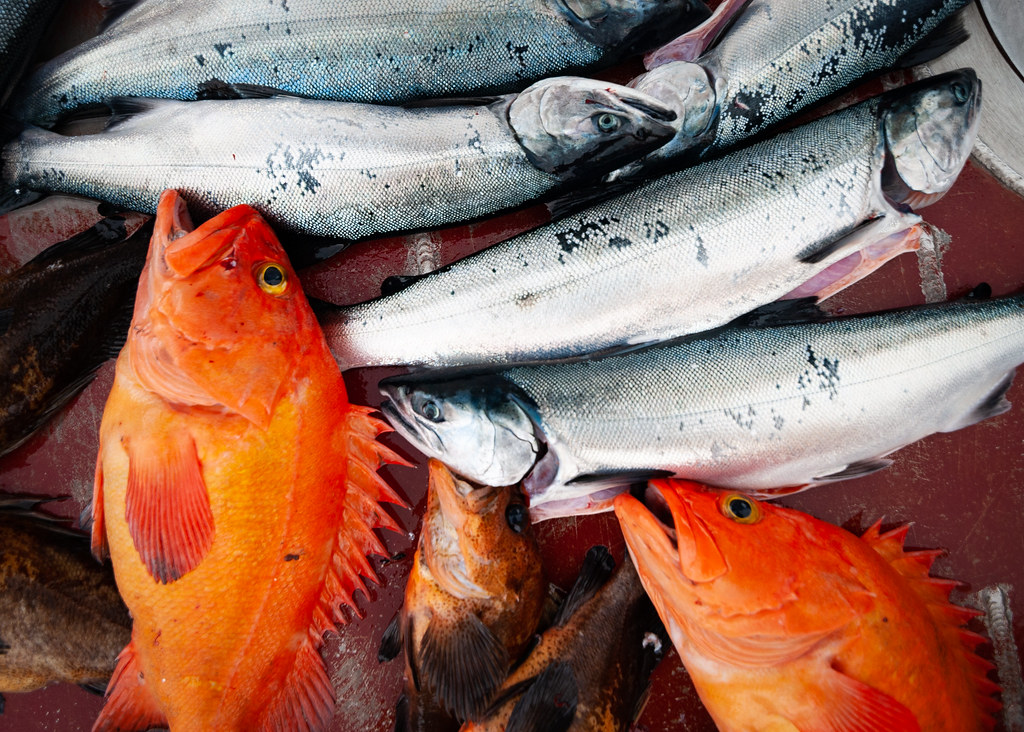
The Alaska Department of Fish and Game announced this month that fishing for yelloweye rockfish is again prohibited in Southeast Alaska this year. Yelloweye are a popular species of rockfish but their populations declined significantly in recent decades, which has Fish and Game biologists concerned.
There are seven species of demersal shelf rockfish (DSR) lurking in the depths of Southeast Alaska – quillback, China, rosethorn, copper, canary, tiger rockfish, and yelloweye. According to Fish & Game, all of them have experienced population decline in recent years but yelloweye are the most populous and perhaps the most popular.
The Fish & Game announcement earlier this month isn’t a change – the commercial fishery in southern Southeast Alaska for demersal shelf rockfish closed in 2020. In the intervening years, the Board of Fish has added restrictions to sport and recreational fishers as well.
All DSR species are still fair game for Southeast subsistence fishers. Nonresidents fishing in any capacity are banned from retaining any demersal shelf rockfish.
New harvest regulations are looser than in previous years. In 2021, retaining any DSR was illegal for a recreational fisherman. This year, Ketchikan residents can take home up to three rockfish, as long as none are yelloweyes.
“We support regulations,” said Chris Baldwin, who has run a charter fishing boat for over a decade. “If Fish & Game thinks that they’re declining, then they need to be protected. That’s kind of my take on the closure.”
Regardless, Baldwin said it is not rare for the big orange fish to end up as bycatch for a halibut or lingcod angler.
“It also presents a challenge when you get those big yelloweyes to descend them. Because we’re required to descend them since we can’t retain them,” Baldwin said.
Rockfish live their whole lives near the seafloor. According to Baldwin, when they are yanked to the surface by a fishing line, the nitrogen in their body expands, making them buoyant. This greatly reduces their chance of returning to deep water or surviving the encounter.
That’s why the Board of Fish required all sport and charter fishermen to have a “descending” device on board.
“It hits a certain pressure and just opens up. So you clamp it around the mouth, I hook it to my downrigger and drop it down and then it releases the fish,” Baldwin demonstrated.
Yelloweye, so named for their prominent yellow eyes, make their homes among the rocks deep below the surface. With their spiny dorsal fin and bright orange, yellow, and red coloring, they could resemble an underwater fireball. They were a popular catch among sport fishermen because of their look, size, and according to Baldwin, they put up a good fight.
They are also one of the longest-living fish species in the world, sometimes surviving to be well over 100 years old – until their Southeast Alaska populations went into freefall.
“It could be a combination of environmental factors like the Blob that happened in the North Pacific, as well as fishing pressures and their life history characteristics. Yelloweye rockfish are particularly vulnerable, because they’re long lived species,” explained ADF&G groundfish biologist Alex McCarrel, listing potential reasons for the decline.
The Blob was a marine heatwave that occurred in the 2010s – a mass of warm water in the north Pacific Ocean that persisted for nearly three years and had a pronounced effect on sea creatures like rockfish.
McCarrel also noted that since yelloweye often live for so long, they grow slowly and mature late, meaning that fishing them on a season-by-season basis can have a major effect on the health of the population. This also means getting the fish back to a healthy level may take longer than other overfished species.
Rhea Ehresmann leads ADF&G’s groundfish monitoring efforts in Southeast. She said they measure demersal shelf rockfish with remotely operated vehicles on the seafloor, as well as data from bycatch in the commercial halibut fishery.
“So that’s how we survey yelloweye rockfish to come up with a density estimate, which gets expanded out to biomass estimate. So we’re doing these surveys that are feeding into stock assessments,” she said.
Just before the 2020 fishery closure, Fish and Game reported a 60% decline in yelloweye biomass since the mid-90s. ADF&G said they will continue monitoring the species with hopes for reopening the fishery in the future. Until then, fishermen will have to continue to descend them back to the deep.
CORRECTION: A previous version of this article stated that the demersal shelf rockfish fishery in the northern part of Southeast Alaska has been closed since 1995. This is a misrepresentation. The Alaska Department of Fish and Game has not opened the directed fishery in the Northern Southeast Outside (NSEO) groundfish management district since 1994 when the stock assessment survey in that
area indicated a low abundance of fish. NSEO is a very small management area in the Gulf of Alaska near the mouth of Cross Sound and is not representative of the whole of northern Southeast Alaska.





